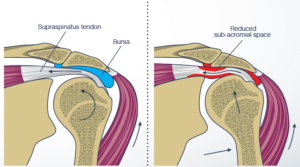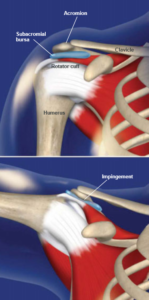What’s up ? This is THE stephane ANDRE. With my training, I’m interested in biomechanics to avoid injuries. I read « Sport Medicine Media Guide » and I learned some good stuff.
Impingement is the fact of having mechanical compression and/or tendon wear of the rotator cuff. Rotator cuff is composed of a serie of 4 muscles connected to the shoulder blade at the humeral head (upper part of the shoulder joint). The function of the rotator cuff is to maintain the humeral head within the glenoid (socket) during normal shoulder function and to participate in shoulder strength during activity. Normally, the rotator cuff glides gently between the inferior surface of the acromion, the bone at the point of the shoulder and the humeral head.
Causes
Any process that can interfere with rotator cuff being able to glide normally can cause impingement. The causes are :
-
Weakening
-
Degeneration of the tendon due to aging
-
Formation of the bone spurs
-
Inflammation of tissues on the space above the rotator cuff
-
Injury due to overuse
Overuse activities that can lead to impingement are most commonly seen in tennis players, pitchers and swimmers.
Diagnosis
Diagnosis can be made with the patient’s history and physical examination. Patients suffering impingement often complain of pain in the shoulder. This pain worsens with overhead activity and can be so strong that it causes an awakening during the night. Manipulation of the shoulder in a specific way by a doctor will usually reproduce the symptoms and confirm the diagnosis. X-rays are also useful for the evaluation of the presence of bone spurs and/or the narrowing of the subacromial space.
Treatment
The first thing to do is to eliminate identifiable causes or factor that contribute to the pain. This means temporarily avoiding activities like tennis, pitching or swimming. A non steroidal anti-inflammatory medication may also be recommended by your doctor. The treatment is based on exercises aimed at restoring flexibility and normal strength to the shoulder girdle, especially by strengthening the muscles of the rotator cuff and the muscles responsible for the normal movements of the scapula (shoulder blade). This program may be performed by a doctor, a certified athletic trainer or a qualified physiotherapist. Sometimes a cortisone injection may be helpful in the treatment.
Surgery
Surgery isn’t necessary in most case of shoulder impingement. But if the symptoms persist despite non-surgical treatment, surgical intervention may be beneficial. Surgery involves deriding or surgically removing, tissue that is irritating the rotator cuff. This can be done with open or arthroscopic technique. The result is favorable in about 90% of cases.
Subscribe to my newsletter and share this article if you think it can help someone you know. Thank you.
-Steph
P.S. If you’re in Miami and you like Caribbean food, go to my cousin’s bistro to eat Haitian food, click here .

